Nestled in Myanmar’s heartland, Bagan is not merely a place. It’s a voyage back in time, where the air is thick with the essence of a thousand years, and the horizon is lined with ancient temples as far as the eye can see. Over 2,000 temples, pagodas, and stupas stand proudly on the plains of Bagan, each with a tale whispering the legacy of the Pagan Kingdom. As dawn breaks, casting a golden glow over these architectural marvels, one can’t help but feel transported to an era where spirituality and artistry reigned supreme. This guide is your portal into the mystical world of Bagan, where every path leads to discovery, and every sunset tells the story of ages past.

The Canvas of the Gods
The Foundation of Faith
The inception of Bagan as a religious and cultural epicenter dates back to the 9th century. It emerged as the heart of the Pagan Empire, where the seeds of Buddhism were sown and flourished across Myanmar. Temples like Ananda and Dhammayangyi stand as monumental testaments to this spiritual awakening. They narrate the empire’s might, its devotion to Buddhism, and its unparalleled contributions to art.
A Symphony in Stone
Bagan’s landscape is a symphony of architectural brilliance. The Sulamani Temple showcases exquisite murals, while the Gubyaukgyi Temple is renowned for its intricate stucco work. Each temple, with its unique charm, contributes to Bagan’s grand mosaic of history and spirituality. The precision of ancient architects and the sanctity of their creations continue to awe visitors.
The Realm of Tranquility
Amidst the towering stupas, there lies a profound tranquility. The Htilominlo Temple, known for its elaborate plaster carvings, offers not just a visual feast but a serene space for contemplation. The silent mornings, broken only by distant chants and the soft flutter of pigeons’ wings, invite introspection. Bagan teaches the art of stillness, amidst relics of the past.
Sunset: A Confluence of Time and Beauty
As the day wanes, Bagan transforms. The setting sun casts a fiery hue across the temples, each silhouette a shadowy guardian of history. The Shwesandaw Pagoda, with its panoramic views, becomes a congregation point for those eager to witness this daily spectacle. It’s a moment of profound beauty, where time stands still, and the present gazes back into the past.
The Living Heritage
Bagan is more than its temples; it’s a living, breathing cultural heritage. The vibrant lacquerware, the bustling Nyaung U Market, and the traditional puppet shows offer glimpses into the Burmese way of life that has thrived alongside these ancient structures. The city, with its resilient spirit, continues to embrace the future while honoring its sacred past. The journey through Bagan is an endless discovery, where history unfolds beneath your feet, and spirituality lingers in the air.
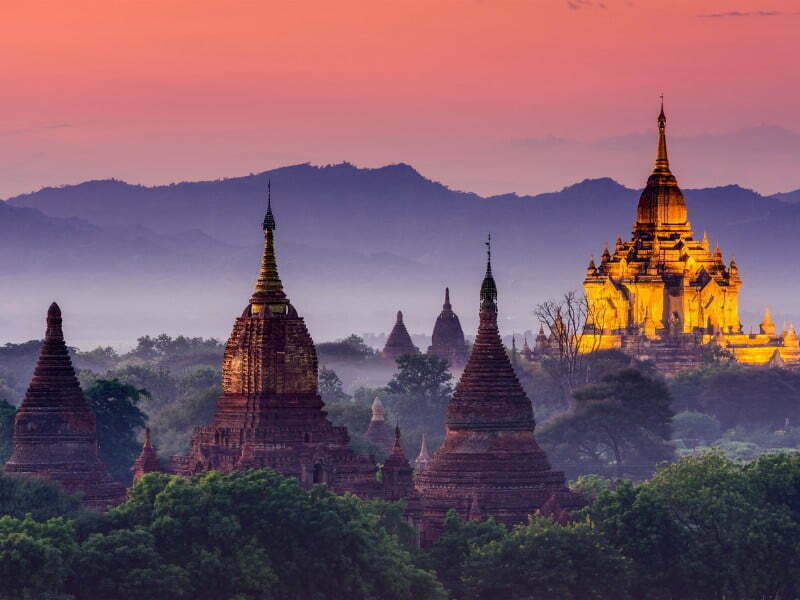
Bagan City Guide: A Brief History Of Bagan, Myanmar
Once the capital of the mighty Pagan Empire, this ancient city is a testament to the spiritual devotion and architectural prowess that flourished from the 9th to 13th centuries. Today, over 2,000 temples, stupas, and pagodas sprawl across its landscape, each telling a tale of faith, artistry, and the rise and fall of empires. Let’s delve into the rich history of Bagan, exploring how it became a beacon of Buddhism and a symbol of eternal beauty.
The Rise of the Pagan Empire
A Spiritual Foundation
Bagan’s story begins in the 9th century when King Anawrahta ascended to the throne. His conversion to Theravada Buddhism marked a turning point. Under his reign, Bagan transformed into a religious center, with the construction of thousands of stupas and temples. This era laid the foundations of Burmese culture and spirituality.
A Flourishing Capital
The city reached its zenith between the 11th and 13th centuries, becoming a cosmopolitan center for religious studies and a hub for trade. Artisans and monks from across Asia were drawn to its gates. The skyline, dotted with golden tips, mirrored the empire’s prosperity. Bagan was a beacon of Buddhism, shining bright in the heart of Myanmar.
The Fall and Preservation
Invaders and Natural Disasters
Despite its spiritual might, Bagan could not withstand the test of time. The 13th century brought invasions and natural disasters. The city faced repeated Mongol attacks, leading to its gradual decline. Yet, the temples stood resilient, guardians of Bagan’s glorious past.
UNESCO Recognition and Restoration
The turn of the 21st century marked a new chapter for Bagan. Efforts to preserve its architectural heritage gained momentum. In 2019, UNESCO finally recognized it as a World Heritage Site. This acknowledgment brought new life to Bagan, ensuring the protection and restoration of its ancient treasures.
Bagan Today: A Legacy Lives On
A Spiritual Pilgrimage
Bagan today is a pilgrimage site for Buddhists and history enthusiasts from around the world. Its temples, such as the majestic Ananda Temple and the mysterious Dhammayangyi Temple, continue to fascinate. The intricate frescoes and stucco decorations tell stories of a bygone era, inviting onlookers into a meditative journey.
Living Among Ruins
Life in Bagan is a harmonious blend of the ancient and the contemporary. Local communities thrive among the ruins, keeping traditions alive. The art of lacquerware, passed down through generations, is a testament to the city’s enduring cultural legacy. Bagan is not just an archaeological site; it’s a vibrant community.
Bagan’s history is a narrative of rise, fall, and rebirth. It stands as a monument to human faith, resilience, and creativity. Each temple, each ruin, has a story, contributing to the tapestry of Myanmar’s history.
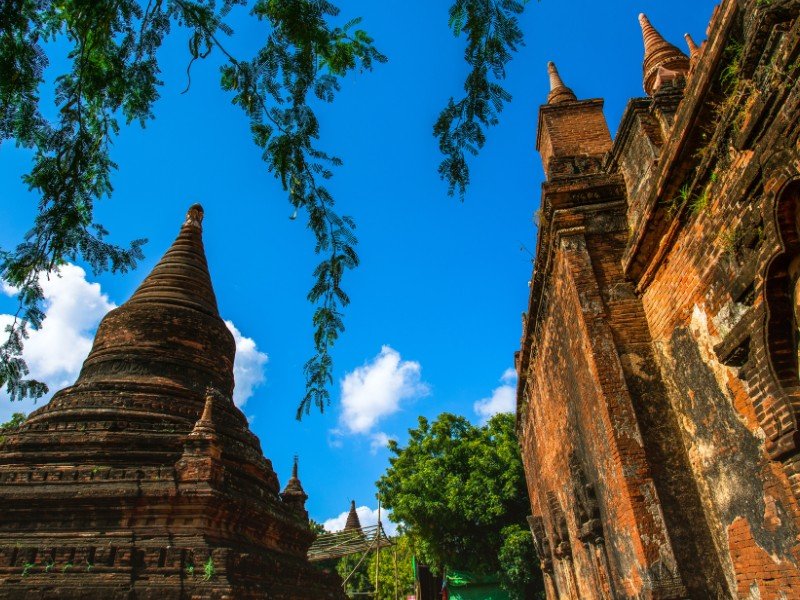
Bagan Top Attractions and Best Places to Visit in Myanmar
Home to the densest collection of Buddhist temples on Earth, Bagan is a bucket list destination for cultural travellers. With most slowly decaying as the years go by, they have taken on an appearance that has made them famous in travel circles. Don’t come to Burma without seeing Bagan, as it is a central part of this country’s identity.
Let’s just say it: Bagan is a culture vulture’s paradise. With temples literally for days, it can be hard to put together a sightseeing itinerary if you are pressed for time. If this is your situation, leave the planning to us – start your time in Bagan by visiting Ananda Temple.
Unlike most of the structures in the ancient city, it is one of four that remains standing in one piece to this day. Within its grounds, you will find no less than four Standing Buddhas, each staring off in each cardinal direction (North, East, South, and West).
Given its magnificent Indian architecture, some have dubbed this over 700-year-old temple as the Westminister Abbey of Burma, so don’t miss this place.
More Attractions
Next, make your way over to the Sulamani Guphaya Temple. Erected for King Narapatisithu in the late 12th century, it was later seen by the Burmese as one of their crowning achievements when it came to the temples of Bagan.
While it was heavily damaged in an earthquake in 1975, it was rebuilt fully by 1994. This spot is one of the most visited in Bagan, so be sure to visit early in the morning if crowds bother you.
Head over to the Shwesandaw Pagoda next, as it is said to contain strands of hair from the Buddha. Apart from these relics, the sizable stupa, terraces, and terracotta tiles of this nearly 1,000-year-old temple are also big reasons why you should include this sacred place in your sightseeing journey.
Many favour this place for photos both at sunrise and sunset, as climbing its tall, steep steps will allow you to capture timeless photos of the sea of temples below, and a sky full of hot air balloons above.
If you find the throngs of people at Shwesandaw Pagoda bothersome, opt instead to head to Bulethi Temple for dawn or dusk. The view of hot air balloons as the day lights up is just as stunning here, and climb you’ll have to make will ensure you earn your view just the same.
Don’t arrive too late, though – while the crowds here aren’t as bad at the other spots, quite a few still make it out to Bulethi. If you don’t like being around people, stop by during midday – just be sure to lather up with sunscreen, or the Burmese sun will scorch you within a half hour.
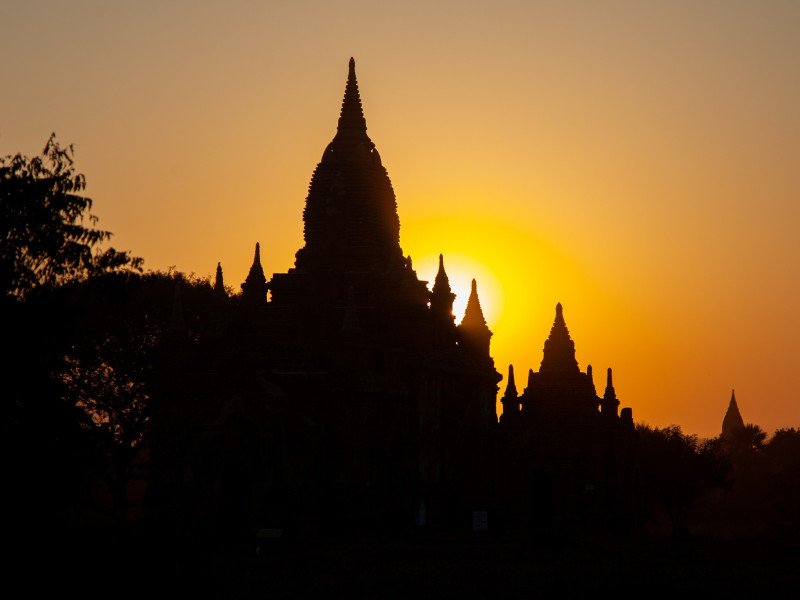
Other Cultural Attractions: Trip to Bagan, Myanmar
Get a good overview of the artifacts recovered from the ruins of the temples of Bagan at the Bagan Archaeological Museum. Here, you’ll find preserved stone reliefs, reclining Buddhas, and models of the temples when they were maintained, among other attractions.
Even if you aren’t that into museums, the ice cold air-con makes this place a refuge from the often relentless heat that bakes the Bagan area outside cool season. If you are into museums, set aside at least two hours to explore – this place is massive.
There is more to Bagan than just temples – you can also explore traditional communities in the area as well. Start with Yandabo Village, as it is well-known for its pottery.
While things have been done traditionally in this community for many years, you’ll be interested to note how modern technology has found its way even into such a remote place, as you’ll find solar panels charging chainsaws used to cut wood to stoke their fire pits.
Other Attractions
Situated along the Irrawaddy River, you can visit it while on a river trip between Bagan and Mandalay, so remember this spot when plotting out your travels along this lazy body of water.
Minnanthu Village is another community you’ll want to include in your travel plans. This village is known in the area as a major agricultural producer, as it harvests sesame seeds and peanuts, and creates oil from said products.
You’ll also get to see residents in traditional dress, how they hand roll the local variety of cigarette, weaving textiles, crafting jewellery, and other pursuits they have engaged in over the generations to make a living.
Some are turned off by this place due to touristy aspects creeping into the background, but if you don’t mind touts, don’t miss visiting this place.
It is one of the most expensive parts of a visit to Bagan, but if you have the change to spare, pay to go on a hot air balloon ride with your travel companion(s). Taking off just as the light of dawn rims the horizon, you’ll soon be privy to one of the most stunning views you’ll see in your life, as countless temples are revealed to you below as the sun lights up the Earth.
source: Expoza Travel on YouTube
Top 20 Things To Do in Bagan, Myanmar For Visitors
Here’s a comprehensive guide to the top 20 things to do in Bagan for an unforgettable experience.
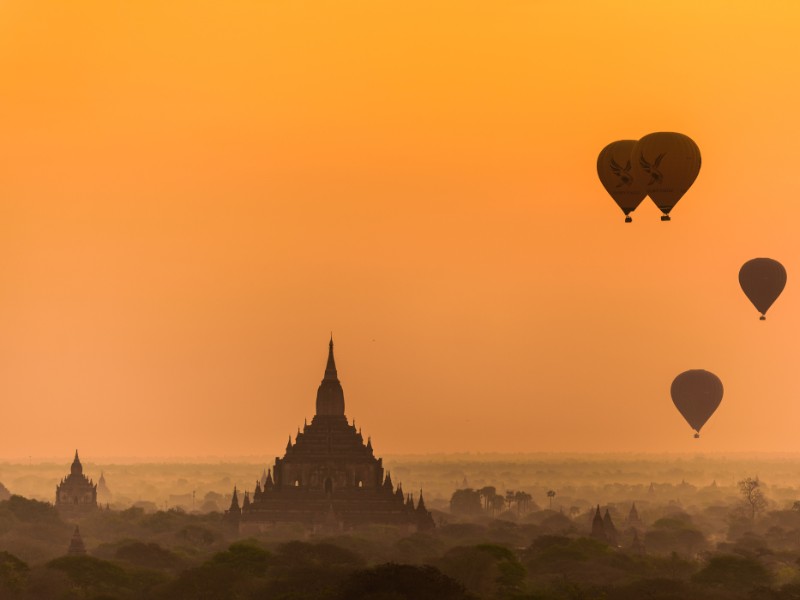
1. Sunrise Hot Air Balloon Ride
A sunrise hot air balloon ride over Bagan is a once-in-a-lifetime experience. You’ll float above ancient temples as the early morning sun paints the sky in vibrant colors. The views of the temple-dotted landscape are breathtaking, offering a serene perspective of Bagan’s vast plains. Most rides end with a champagne breakfast upon landing, adding a touch of luxury to this adventure. It’s an unforgettable way to experience the beauty and tranquility of Bagan from a unique vantage point.
- Best for: Early risers and adventure seekers.
- Tip: Book in advance as rides fill up quickly during peak season.
- Highlight: Spectacular aerial views of the temples at dawn.
2. Explore Ananda Temple
Ananda Temple is one of Bagan’s most magnificent and revered sites, featuring a blend of Mon and Indian architecture. Built in the 12th century, it’s renowned for its four standing Buddha statues, each facing a cardinal direction, representing serenity and wisdom. The temple’s corridors are adorned with intricate carvings and ancient frescoes, telling stories of Buddhist teachings. A visit here is both a spiritual journey and an architectural exploration, offering insight into Bagan’s rich cultural and religious heritage.
- Best for: History and architecture lovers.
- Tip: Visit early to avoid the crowds.
- Highlight: Intricately carved Buddha statues and preserved murals.
3. Cycling Around the Archaeological Zone
Cycling through the Bagan Archaeological Zone is a great way to experience the temples up close at your own pace. With over 2,000 temples spread across the plains, renting a bicycle allows for spontaneous detours to explore lesser-known ruins. The flat landscape and scenic paths make cycling a popular and accessible way to navigate Bagan. It’s an adventure that blends history, exercise, and exploration, providing a sense of freedom as you pedal through centuries-old sites.
- Best for: Active travelers and adventurers.
- Tip: Start early to avoid the midday heat.
- Highlight: Discovering hidden temples off the beaten path.
4. Visit Dhammayangyi Temple
The massive Dhammayangyi Temple, known as Bagan’s largest temple, is steeped in legend and mystery. Built by King Narathu, who was said to be a tyrant, this temple is notable for its precise brickwork, with stones laid so tightly that even a pin can’t pass through. Although the interior remains unfinished, its sheer size and architectural significance make it a must-see. Walking through the eerie corridors, visitors are transported back to a time of opulence and power.
- Best for: History buffs and architecture enthusiasts.
- Tip: Visit with a guide to learn the legends behind the construction.
- Highlight: Intricate, perfectly laid brickwork.
5. Sunset at Shwesandaw Pagoda
Shwesandaw Pagoda offers one of the most stunning sunset views in Bagan. Climbing its terraces gives you a panoramic perspective of the temple-strewn plains, with the fading light casting a golden glow over the landscape. The sight of temples rising from the mist as the sky changes color is truly magical. It’s one of Bagan’s most popular sunset spots, so arriving early to secure a good viewpoint is recommended. Watching the sunset here is a peaceful and awe-inspiring experience.
- Best for: Sunset chasers and photographers.
- Tip: Get there early to avoid the crowds.
- Highlight: Panoramic views of the temples at sunset.
6. Take a Boat Trip on the Ayeyarwady River
A boat trip on the Ayeyarwady River offers a tranquil way to experience Bagan’s temples from a different perspective. Many boats offer sunset cruises, where the ancient stupas are silhouetted against the golden horizon. For a deeper cultural immersion, some trips include stops at nearby villages along the riverbank. Whether it’s a short sunset cruise or a longer journey, the serene waters and stunning views make for a peaceful retreat from the temple tours.
- Best for: Those seeking a peaceful escape.
- Tip: Opt for a sunset cruise for the best views.
- Highlight: Scenic river views of the temples at dusk.
7. Discover the Gubyaukgyi Temple (Myinkaba)
Gubyaukgyi Temple in Myinkaba is famed for its well-preserved murals, offering a glimpse into ancient Buddhist teachings. The temple is a fine example of Mon architecture and is adorned with beautiful stucco work on the outside. Inside, the walls are painted with Jataka tales that narrate the past lives of the Buddha. This temple is a must-see for those interested in art history, as the murals remain one of Bagan’s most significant artistic treasures.
- Best for: Art lovers and historians.
- Tip: Bring a flashlight to better view the interior murals.
- Highlight: Exquisite, well-preserved frescoes depicting Buddhist tales.
8. Explore the Bagan Archaeological Museum
The Bagan Archaeological Museum is a treasure trove of artifacts, sculptures, and ancient relics from the Bagan period. The museum’s exhibits include bronze statues, inscriptions, and stone carvings that provide a deeper understanding of the region’s cultural and religious history. It’s a comprehensive stop for visitors who want to gain context before or after exploring the temples. The museum’s spacious halls and informative displays bring the grandeur of ancient Bagan to life.
- Best for: History and archaeology enthusiasts.
- Tip: Spend time on the top floor for the best views of the surrounding temples.
- Highlight: Detailed explanations of the history and significance of Bagan’s temples.
9. Walk Through Old Bagan
Old Bagan is where the city’s ancient heart beats strongest. Walking through the quiet streets of this area offers a blend of temple ruins, monasteries, and small markets. Among the bustling historical sites, you’ll also find local communities, giving visitors a chance to see daily life continuing amidst the ancient surroundings. The Tharabar Gate is the gateway into this world, providing a stark contrast between modernity and antiquity.
- Best for: Those looking to combine history with local culture.
- Tip: Explore early morning for a quieter experience.
- Highlight: Local life intertwined with the ruins.
10. Attend a Traditional Puppet Show
Bagan’s traditional puppet shows offer a glimpse into the art of Burmese storytelling through colorful marionettes. These shows often depict local legends, Buddhist tales, and even historical dramas using intricately crafted puppets. Performances usually take place in restaurants or cultural centers during the evenings, providing entertainment alongside a traditional meal. It’s an enchanting cultural experience that combines music, history, and artistry.
- Best for: Culture enthusiasts and families.
- Tip: Arrive early for good seats, as these shows are popular.
- Highlight: Beautifully crafted puppets and captivating storytelling.
11. Photography Tour at Sunrise or Sunset
Bagan’s sunrise and sunset are nothing short of magical, making it a photographer’s paradise. Joining a photography tour ensures you capture the perfect shot, guided by experts who know the best angles and hidden spots. As the temples glow under the changing light, you’ll have the opportunity to frame these iconic moments beautifully. These tours are designed for all levels, whether you’re a seasoned professional or a hobbyist looking to improve your skills.
- Best for: Photography lovers.
- Tip: Bring a tripod for early morning or evening shots.
- Highlight: Capturing the ethereal beauty of Bagan’s temples during golden hour.
12. Learn Lacquerware Art in a Local Workshop
Bagan is renowned for its lacquerware, and taking part in a workshop allows you to learn this ancient craft firsthand. Artisans guide you through the process of creating intricate designs on lacquered objects, a skill that has been passed down through generations. From applying layers of lacquer to engraving delicate patterns, you’ll gain insight into the artistry behind these traditional items. Workshops often let you create your own piece to take home as a meaningful souvenir.
- Best for: Art and culture enthusiasts.
- Tip: Visit a lacquerware shop afterward to see more intricate designs.
- Highlight: Creating a personalized lacquerware item with the guidance of local craftsmen.
13. Relax at a Spa with Traditional Burmese Treatments
After a day of exploring temples, relax and rejuvenate at a spa offering traditional Burmese treatments. These treatments often use local ingredients like herbs, oils, and clay to cleanse and refresh the body. Massages are influenced by ancient wellness practices, promoting both physical and mental well-being. Many spas also offer stunning views of the Bagan landscape, adding to the overall serenity and relaxation.
- Best for: Wellness seekers and weary travelers.
- Tip: Opt for a package that includes a body scrub followed by a soothing massage.
- Highlight: The combination of traditional techniques and natural ingredients provides a deeply relaxing experience.
14. Visit Thatbyinnyu Temple
As one of Bagan’s tallest temples, Thatbyinnyu Temple offers visitors a striking example of Bagan’s grandeur. Built in the 12th century, this towering structure stands at 66 meters tall and provides an impressive sight amidst the sprawling temple plain. The temple’s architecture is a reflection of the transition from early to later styles in Bagan, with both solid and hollow elements incorporated into the design. Its name translates to “Omniscience”, symbolizing Buddha’s infinite knowledge.
- Best for: Temple enthusiasts and history buffs.
- Tip: Visit during the afternoon for fewer crowds.
- Highlight: Thatbyinnyu’s towering structure and spiritual significance.
15. Partake in a Cooking Class Featuring Burmese Cuisine
Learning to cook Burmese cuisine is an immersive way to dive into the local culture. Classes typically begin with a market tour, where you’ll choose fresh ingredients alongside a local chef. You’ll then be guided through the preparation of traditional dishes like Mohinga (a fish soup) or Laphet Thoke (tea leaf salad). The experience ends with a communal meal where you enjoy the fruits of your labor. It’s a delicious, hands-on way to connect with Burmese traditions.
- Best for: Foodies and cultural explorers.
- Tip: Ask for tips on where to find authentic spices to take home.
- Highlight: Enjoying a meal you’ve prepared from scratch using traditional methods.
16. Explore Minnanthu Village
Escape the crowds and visit Minnanthu Village, where the pace of life slows down amidst temples and farmland. This area is quieter than the more popular temple zones, allowing for peaceful exploration of ancient stupas and local monasteries. The village itself offers an intimate look into the daily life of the locals, with opportunities to engage in conversations and observe traditional farming practices. It’s a serene getaway within Bagan’s rich history.
- Best for: Those seeking peace and cultural immersion.
- Tip: Hire a local guide to enhance your visit with historical context.
- Highlight: Quiet, off-the-beaten-path exploration of temples and village life.
17. Take a Day Trip to Mount Popa
Just an hour’s drive from Bagan, Mount Popa is a dormant volcano and spiritual pilgrimage site, revered as the home of Myanmar’s Nats (spirits). The climb to the top is 777 steps, leading to a monastery perched on the summit, offering panoramic views of the surrounding plains. The journey is filled with monkeys, shrines, and colorful statues, creating a lively atmosphere. It’s a rewarding day trip that blends natural beauty with cultural reverence.
- Best for: Adventure seekers and those interested in spirituality.
- Tip: Bring water and wear comfortable shoes for the climb.
- Highlight: The breathtaking views from the summit and the vibrant spirit of the pilgrimage.
18. Savor Bagan’s Street Food
Bagan’s street food scene offers an array of flavors that reflect the region’s rich culinary heritage. Sample dishes like tea leaf salad, samosa soup, and freshly made pancakes as you wander through the local markets. Evening food stalls are the best places to start your culinary adventure, where you’ll find an assortment of snacks, meals, and desserts. Eating street food not only satisfies your taste buds but also provides a glimpse into the everyday life of Bagan.
- Best for: Food lovers and culinary explorers.
- Tip: Try Shwe Yin Aye, a popular Burmese dessert.
- Highlight: The diversity of flavors and the vibrant street market atmosphere.
19. Attend a Traditional Burmese Dance Performance
Immerse yourself in Burmese culture by attending a traditional dance performance, where stories of mythology and history come to life through intricate movements and vibrant costumes. These performances often depict local folklore, Buddhist teachings, or royal court life, accompanied by live music from traditional instruments. It’s an engaging way to experience Myanmar’s artistic heritage and appreciate the elegance of its cultural traditions.
- Best for: Culture lovers and those interested in performing arts.
- Tip: Check schedules for performances at cultural centers or local hotels.
- Highlight: The blend of storytelling, music, and dance in a vibrant cultural performance.
20. Visit Sulamani Temple
The Sulamani Temple, built in the late 12th century, is known as the “Crowning Jewel” of Bagan. Its intricate brickwork and well-preserved frescoes are among the finest examples of Bagan’s architectural artistry. The temple’s large central structure is surrounded by smaller stupas, making it a prominent feature in the landscape. Sulamani’s peaceful atmosphere and ornate interior decorations make it a favorite among visitors.
- Best for: Architecture and art enthusiasts.
- Tip: Visit in the late afternoon for softer lighting inside the temple.
- Highlight: The detailed frescoes that adorn the temple’s walls.

What To Eat and Drink in Bagan, Myanmar
Here’s a guide to what you should eat and drink while in Bagan to truly immerse yourself in the local cuisine.
Mohinga
Often considered the national dish of Myanmar, Mohinga is a must-try in Bagan. This savory fish soup is served with rice noodles and is richly flavored with lemongrass, garlic, ginger, and onion. Typically eaten for breakfast, it can be found at local markets and street food stalls throughout the day.
Tea Leaf Salad (Laphet Thoke)
This iconic Burmese dish is a unique combination of flavors and textures. Fermented tea leaves are mixed with cabbage, tomatoes, nuts, peas, and sometimes dried shrimp, then dressed with fish sauce, lime, and garlic oil. It’s a refreshing and slightly caffeinated treat that’s both delicious and distinctive.
Shan Noodles
Originating from the Shan State, Shan noodles are a popular dish throughout Myanmar, including Bagan. These rice noodles are served in a tomato-based sauce with chicken or pork and topped with pickled vegetables. Enjoy them either as a soup or a salad for a taste of local comfort food.
Burmese Curry
Burmese curry is a staple dish that comes in many varieties, including chicken, beef, pork, and fish. These curries are milder than their Indian or Thai counterparts, focusing on a rich mix of spices and herbs rather than heat. Meals are typically served with rice and a variety of side dishes including vegetables, salads, and soups.
Grilled Street Food
Bagan’s streets come alive in the evening with vendors grilling up all sorts of meats, seafood, and vegetables. Skewers of chicken, beef, and even whole fish are marinated in local spices and grilled to perfection. It’s a great way to sample different flavors while mingling with locals.
Palm Sugar Sweets
Palm sugar, derived from the sap of toddy palms, is a common sweetener in Myanmar. In Bagan, you’ll find a variety of sweets made from palm sugar, including candies, cakes, and puddings. These treats are not overly sweet and offer a glimpse into traditional Burmese confectionery.
Myanmar Beer
When it comes to drinks, Myanmar Beer is the local favorite. This crisp, refreshing lager is perfect for cooling down after a day of temple exploration. Enjoy it at a local café or restaurant while watching the sunset over the pagodas.
Burmese Tea
Tea shops are a cornerstone of Burmese culture, and no visit to Bagan would be complete without spending time in one. Traditional Burmese tea is strong and sweet, often served with condensed milk. It’s accompanied by an array of snacks and offers a window into the daily life of the locals.
Tamarind Flakes
Tamarind is widely used in Burmese cuisine, both in savory dishes and as a snack. In Bagan, you’ll find tamarind flakes, which are sweet and sour in taste and can be eaten alone or used as a flavoring in cooking. They make for a great snack while touring the temples.
Fresh Tropical Fruits
Bagan’s markets are brimming with fresh, tropical fruits such as mangoes, papayas, bananas, and durian. The fruit here is incredibly fresh and flavorful, making for a healthy and delicious snack any time of day.

Top Restaurants In Bagan, Myanmar
While Bagan is primarily known for its breathtaking temples and rich history, the dining experiences available here add another layer of richness to any visit. Here’s a list of top restaurants in Bagan that cater to a variety of tastes, ensuring every meal becomes a memorable part of your journey.
1. Sanon Training Restaurant
A gem in Bagan’s culinary scene, Sanon Training Restaurant not only serves exquisite Myanmar and fusion dishes but also operates as a social enterprise, training local youth in hospitality. The restaurant’s garden setting provides a serene dining atmosphere, and their commitment to using locally sourced ingredients ensures each dish is fresh and flavorful.
2. The Moon (Be Kind to Animals)
Famous for its vegetarian and vegan-friendly menu, The Moon offers a tranquil dining experience near the ancient temples. The restaurant is known for its tea leaf salad, pumpkin curry, and fresh juices, making it a perfect spot for a wholesome meal amidst a day of exploring.
3. Weather Spoon’s Bagan Restaurant and Bar
Popular among tourists for its lively ambiance and diverse menu, Weather Spoon’s offers everything from traditional Burmese dishes to Western favorites like burgers and pasta. Their cocktails and smoothies are a hit, especially after a long day of sightseeing.
4. Yar Pyi Vegetarian Restaurant
Located in New Bagan, Yar Pyi is a haven for vegetarians and anyone looking to enjoy traditional Burmese dishes made from fresh, local produce. The restaurant’s friendly atmosphere and delicious food, such as the avocado salad and vegetable curry, have made it a favorite among visitors.
5. Nanda Restaurant and Puppet Show
Offering a unique combination of dining and entertainment, Nanda Restaurant features traditional Burmese puppet shows with dinner. This experience allows guests to indulge in local cuisine while enjoying an art form that has been part of Myanmar’s cultural heritage for centuries.
6. Star Beam Bistro
Star Beam Bistro is a cozy restaurant known for its fusion of Burmese and international cuisine, offering a range of dishes that cater to various tastes. The bistro’s relaxed setting makes it an ideal spot for dinner after a busy day, with standout dishes including the Burmese-style grilled fish.
7. Black Rose Restaurant
Black Rose Restaurant in New Bagan is celebrated for its authentic Burmese flavors and warm hospitality. The restaurant offers a variety of traditional dishes, with their curry meals being particularly popular. Guests can enjoy a comfortable dining experience with both indoor and outdoor seating options.
8. La Terrazza
For those craving Italian cuisine, La Terrazza offers a delightful menu of pasta, pizza, and more, all prepared with a touch of Italian authenticity. The restaurant’s pleasant outdoor seating area provides a great ambiance for enjoying a meal under the stars.
9. Queen Restaurant
Queen Restaurant is well-regarded for its extensive menu featuring Burmese, Chinese, and Thai cuisine. It’s a great place to sample a wide range of dishes, including local specialties and regional favorites, in a comfortable and welcoming setting.
10. A Little Bit of Bagan
This charming café and restaurant is known for its excellent service and delicious breakfast and brunch options. A Little Bit of Bagan serves a mix of Burmese and Western dishes, making it a perfect start to your day of temple exploration.
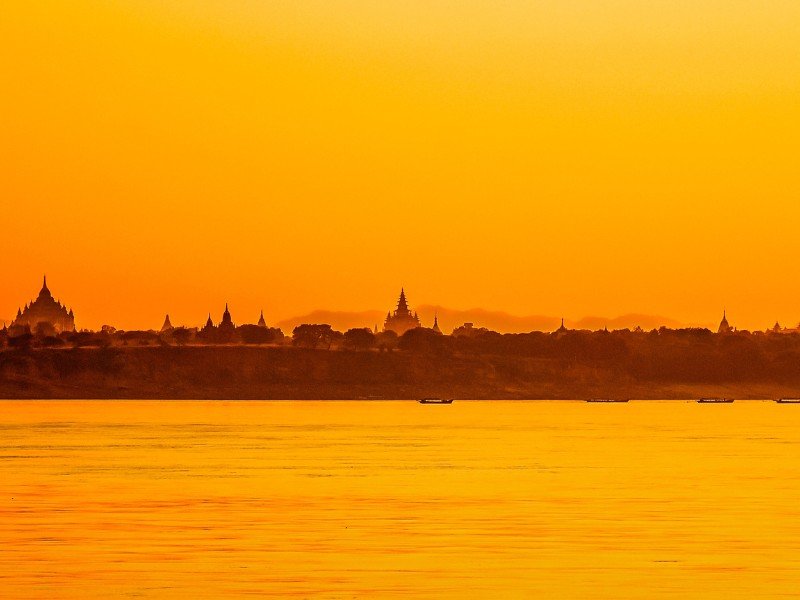
Tours For Visitors To Bagan, Myanmar
To truly appreciate the depth and beauty of Bagan, engaging in guided tours can provide insightful perspectives and unique experiences. Here’s a comprehensive list of tours that cater to various interests, ensuring visitors make the most of their time in this mesmerizing city.
1. Temple Exploration Tours
Dive into the heart of Bagan’s architectural heritage with a guided temple tour. Expert guides share stories behind iconic structures like Ananda Temple, Dhammayangyi Temple, and Thatbyinnyu Temple, unraveling the history and architectural marvels of the ancient city. These tours often include visits to lesser-known temples, offering a glimpse into hidden gems.
2. Hot Air Balloon Rides
Experience Bagan from a bird’s-eye view with a hot air balloon ride at sunrise. Floating above the temple-studded plains offers a breathtaking perspective and unparalleled photo opportunities. It’s a magical experience, watching the first rays of light illuminate the ancient landscape.
3. E-Bike Tours
Cover more ground and venture off the beaten path with an e-bike tour of Bagan. E-bikes offer an eco-friendly way to navigate between temples, through villages, and across fields, providing a blend of cultural and adventurous exploration. Guides lead the way to some of Bagan’s most picturesque spots that are not easily accessible by car.
4. River Cruise on the Irrawaddy
Embark on a river cruise along the Irrawaddy River for a different perspective of Bagan. These cruises often include sunset views, offering a serene experience as you glide past riverside villages and get a glimpse of daily life by the water. Some tours also offer meals and cultural performances on board.
5. Traditional Craft Workshops
Gain hands-on experience in traditional Myanmar crafts, such as lacquerware, a Bagan specialty. Workshops guide visitors through the intricate process of creating lacquerware, from bamboo weaving to etching and polishing, providing insight into this delicate art form.
6. Cultural and Village Tours
Immerse yourself in the local way of life with a tour that takes you through Bagan’s surrounding villages. Learn about traditional agricultural practices, visit local markets, and interact with residents for a genuine understanding of life in and around Bagan. These tours often include a visit to a local monastery to learn about monastic life.
7. Cooking Classes
Delve into the flavors of Burmese cuisine with a cooking class in Bagan. Local chefs teach participants how to prepare traditional dishes using fresh, local ingredients. It’s a tasty way to learn about the culture and bring a piece of Bagan back home with you.
8. Archaeological Site Tours
For history buffs, specialized archaeological tours offer a deep dive into Bagan’s past. Led by experts in Myanmar’s history and archaeology, these tours provide detailed insights into the construction techniques, historical significance, and conservation efforts of Bagan’s ancient sites.
9. Sunrise and Sunset Tours
Capture the ethereal beauty of Bagan at the most magical times of day. Sunrise tours often include a visit to a vantage point for panoramic views, while sunset tours might combine temple visits with a relaxing end to the day overlooking the Irrawaddy River. Both options offer stunning photo opportunities and a chance to see the landscape in its most beautiful light.
10. Pagoda Meditation Retreats
For a truly spiritual experience, participate in a meditation retreat at one of Bagan’s tranquil pagodas. Guided by Buddhist monks, these retreats offer a chance to learn about Buddhist teachings and practice meditation in a serene setting.
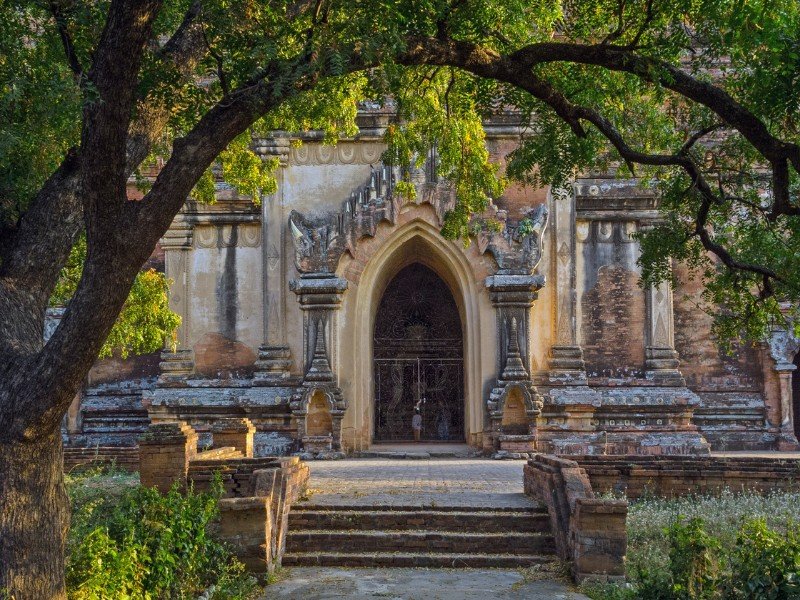
Bagan Accommodations Guide: Hotels, Guesthouses and Hostels
Here’s a comprehensive travel guide to where you might consider staying when visiting this enchanting city, ensuring your trip is as comfortable as it is memorable.
Luxury Resorts
1. Aureum Palace Hotel & Resort Bagan
Perched near the archaeological zone, Aureum Palace is a haven of luxury, offering stunning views of the pagodas. With its spacious villas, on-site spa, and infinity pool, it promises an unparalleled stay in the heart of ancient Bagan.
2. Bagan Lodge
Bagan Lodge blends luxury with the charm of safari-style tents, providing a unique accommodation experience. It’s equipped with modern amenities, a spa, and two swimming pools, making it an oasis of comfort in the dusty plains.
Mid-Range Hotels
3. The Hotel @ Tharabar Gate
Located by the Tharabar Gate, this hotel offers easy access to Old Bagan’s temples. It features comfortable rooms, an outdoor pool, and a restaurant serving both local and international dishes, making it a convenient base for exploration.
4. Bagan Thande Hotel
Situated on the banks of the Irrawaddy River, Bagan Thande Hotel is known for its colonial charm and serene garden setting. It offers a range of rooms and bungalows, some with direct views of the river, alongside a spa and outdoor pool.
Budget Accommodations
5. Ostello Bello Bagan
Ostello Bello is a favorite among backpackers, offering both private rooms and dorms. It’s a social hostel with a lively atmosphere, organizing tours and activities that make exploring Bagan easy and fun.
6. BaobaBed Hostel Bagan @ Bagan May
BaobaBed Hostel combines comfort with affordability, providing clean, modern dormitories and private rooms. It’s a great option for travelers looking to meet others, with a communal lounge and rooftop terrace for socializing.
Guesthouses
7. Shwe Nadi Guest House
For a more local experience, Shwe Nadi Guest House offers simple, clean accommodation with warm hospitality. It’s an excellent choice for travelers on a budget, providing basic amenities and a tasty breakfast.
8. May Kha Lar Guest House
Located within walking distance of several restaurants and shops, May Kha Lar offers comfortable rooms at affordable prices. Guests appreciate the helpful staff and the guesthouse’s proximity to major attractions.
Unique Stays
9. Heritage Bagan Hotel
Embracing the rich history of its surroundings, Heritage Bagan features traditional architecture and décor. Its tranquil setting, outdoor pool, and on-site dining options offer a restful retreat after a day of temple hopping.
10. Bagan Thiripyitsaya Sanctuary Resort
Set on the banks of the Irrawaddy River, this resort offers stunning sunset views, lush gardens, and a sense of tranquility. With a range of accommodations and a riverside pool, it’s a peaceful haven for relaxation.
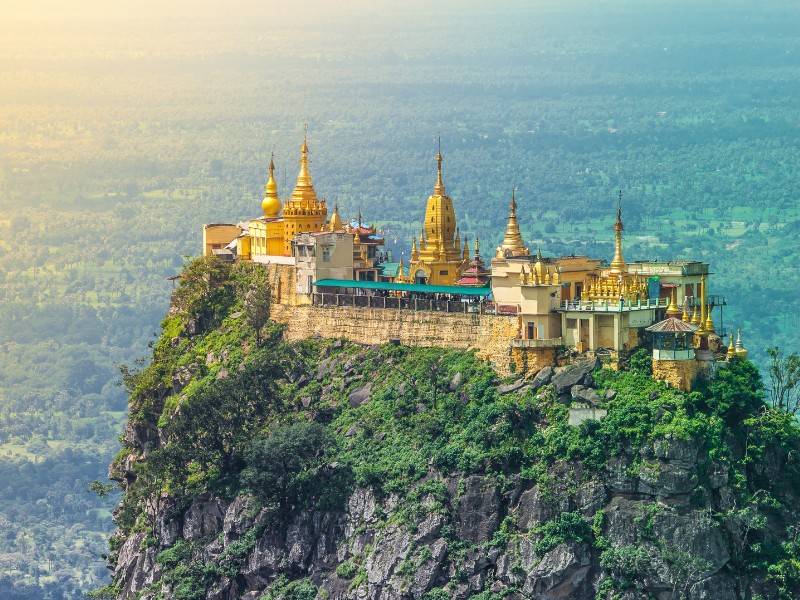
Day Trips From Bagan, Myanmar
Here’s a selection of day trips from Bagan, each offering unique experiences that range from natural wonders to cultural and historical explorations.
1. Mount Popa
An extinct volcano considered to be the abode of Myanmar’s most powerful nats (spirits), Mount Popa is about an hour’s drive from Bagan. The climb to the top, via 777 steps, rewards travelers with panoramic views and a visit to the Popa Taungkalat monastery perched on the summit. It’s a spiritual journey and a physical challenge, surrounded by lush forests and macaque monkeys.
2. Salay
A small town steeped in history, Salay is an easy drive from Bagan and offers a quieter, less-visited cultural experience. Home to beautiful monasteries, including the wooden Yoke Sone Kyaung monastery with its exquisite carvings, Salay provides a glimpse into rural Burmese life. The town is also famous for its colonial-era buildings and the largest lacquer Buddha image in Myanmar.
3. Pakokku
Reachable by a short boat ride across the Irrawaddy River, Pakokku is known for its tobacco trade and traditional weaving workshops. Visitors can explore the local market, visit a cheroot (Burmese cigar) factory, and see how Myanmar’s traditional longyi (sarong) is made. Pakokku presents an authentic slice of Burmese life, offering insights into the country’s crafts and daily routines.
4. Minanthu Village
Minanthu is a quiet village located amidst Bagan’s temples, where visitors can see rural life unfold amidst ancient ruins. This area offers a more intimate experience of Bagan’s landscape, with opportunities to visit farming families and learn about traditional agriculture. Exploring Minanthu provides a contrast to the more touristy areas of Bagan, showing the timeless connection between the land and its people.
5. Kyaukpadaung and the Road to Mandalay
While technically not a day trip, the journey towards Kyaukpadaung leads to the famous “Road to Mandalay.” Travelers can explore local markets and the countryside before heading to Mandalay for further adventures. This route offers stunning landscapes and a taste of the rural charm that Myanmar is known for.
6. Myinkaba Village
Just a short bike ride or walk from Old Bagan, Myinkaba is renowned for its lacquerware workshops. Visitors can observe the intricate process of creating lacquerware, one of Myanmar’s most famous crafts. Myinkaba also boasts several impressive temples, including Gubyaukgyi, with its well-preserved murals.
7. Tant Kyi Taung Pagoda
Located across the river from Bagan, Tant Kyi Taung Pagoda is one of the four pagodas believed to enshrine a Buddha relic. The journey there involves a boat trip and a drive up the hill, offering spectacular views of the Irrawaddy River and Bagan plains. It’s a pilgrimage site that provides a serene and spiritual experience.
8. Nyaung U Market
For those looking to immerse themselves in local culture, Nyaung U Market offers a bustling atmosphere where you can find everything from fresh produce to traditional crafts. It’s an excellent place for photography, sampling local foods, and observing everyday life in Myanmar. Nyaung U is the gateway to Bagan, making it easily accessible for travelers.
9. Nat Ma Taung / Mount Victoria
For a longer day trip or overnight excursion, Nat Ma Taung (also known as Mount Victoria) in the Chin State offers breathtaking natural landscapes. It’s a haven for trekkers, with rich biodiversity and opportunities to visit remote tribal villages. This trip is for the adventurous, seeking to explore Myanmar’s diverse ethnic heritage and natural beauty.
10. Ayeyarwady River Cruise
A day cruise on the Ayeyarwady River presents a relaxing way to see the countryside from a different perspective. These cruises often include stops at riverside villages and provide a glimpse into the importance of the river for transportation and irrigation. It’s a peaceful experience, showcasing the timeless flow of life along Myanmar’s most significant waterway.
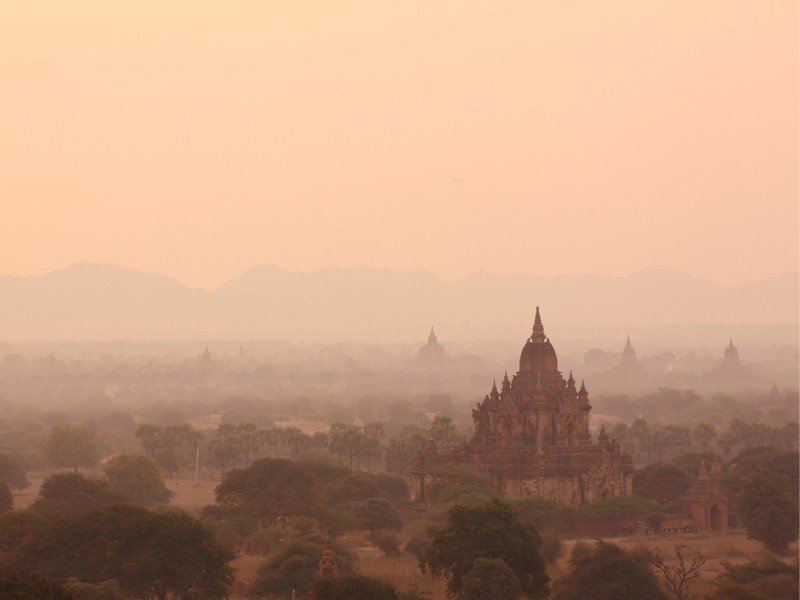
Bagan Transportation Guide
Here’s a detailed travel guide to help you choose the best way to explore Bagan’s rich tapestry of temples, landscapes, and riverside vistas.
1. E-Bikes
E-bikes are the go-to mode of transport for exploring Bagan’s archaeological sites, providing a perfect balance between convenience and environmental friendliness. They’re quiet, allowing you to immerse fully in the serene atmosphere of the ancient city. Most rental shops offer them at competitive rates, and you can easily cover a lot of ground without exerting too much physical effort. Remember to check the battery life and bring a map or a GPS-enabled device to navigate the sprawling temple complex efficiently.
2. Bicycles
Renting a bicycle offers a rewarding and eco-friendly way to explore Bagan at a slower pace, allowing for unplanned detours and discoveries. Cycling through the dusty paths and along the Irrawaddy River gives a sense of adventure and connection to the landscape. It’s also an excellent way to interact with locals, stopping at small villages and teahouses along the way. Ensure your bike is equipped with a comfortable seat and a basket for carrying water and essentials.
3. Horse Carts
For a touch of romance and nostalgia, horse cart rides through Bagan offer a unique perspective of the ancient city. The clip-clop of hooves on the sandy paths and the leisurely pace allow for ample photo opportunities and a chance to appreciate the intricate details of each temple. Drivers often share stories and insights about the temples, adding a personal touch to the experience. It’s a more traditional way to travel and supports the local economy.
4. Taxis and Private Cars
Hiring a taxi or a private car with a driver can be an excellent option for those looking for comfort, especially during the hotter parts of the day or for visits to more remote areas outside Bagan. Air-conditioned cars offer a respite from the heat, and drivers can provide valuable local knowledge about the sites. This option is ideal for families, groups, or those limited on time, wanting to maximize their visit without the physical strain. Negotiate the price beforehand, and consider hiring the same driver for multiple days for better rates.
5. Motorbikes
For experienced riders, motorbikes offer the freedom to explore Bagan and its outskirts on your terms. They’re faster than e-bikes and bicycles, allowing for expeditions to lesser-visited temples, villages, and natural sites. It’s important to be mindful of local regulations regarding motorbike rentals to tourists and to always prioritize safety by wearing helmets and avoiding off-road paths that may be hazardous. Check with your accommodation for reputable rental services.
6. Local Buses
Local buses are a lifeline for longer journeys to and from Bagan, connecting the city with other major destinations across Myanmar. While not the most comfortable option, they offer an authentic local experience and are incredibly cost-effective. Buses vary in quality, so it’s worth paying a little extra for a VIP or express service, which will have air conditioning and more spacious seating. Book tickets in advance during peak travel seasons to secure your seat.
7. Boats
Taking a boat trip on the Irrawaddy River is a serene way to experience the beauty of Myanmar’s lifeline, offering a different perspective of Bagan and the rural life along the banks. Sunset cruises are particularly popular, providing stunning views as the sun dips below the horizon. Longer journeys to places like Mandalay are also available, turning the travel between cities into a scenic voyage. Check the schedule and book in advance, as services can vary seasonally.
8. Hot Air Balloons
Though not a mode of transport for exploring Bagan’s grounds, hot air balloon rides offer an unforgettable aerial view of the temple landscape at sunrise. It’s a once-in-a-lifetime experience, witnessing the ancient city awash in the morning’s first light. Bookings should be made well in advance, especially during the peak tourist season from November to February. It’s a higher-budget activity but well worth the expense for the unparalleled views and the thrill.
9. Walking
Exploring Bagan on foot is perhaps the best way to truly connect with the history and spirit of the place. Walking allows for a detailed exploration of the temples, an appreciation of the intricate artwork, and a chance to find hidden nooks not accessible by larger vehicles. Start early to avoid the midday heat, carry plenty of water, and wear comfortable shoes. It’s ideal for shorter distances within the main temple areas or the village of Nyaung U.
10. Tuk Tuks and Trishaws
For short distances or when navigating the areas around Nyaung U and New Bagan, tuk-tuks and trishaws offer a quick and local mode of transport. They’re perfect for zipping between sites, visiting local markets, or when you’re simply too tired to walk or bike. Negotiate the fare before starting your journey, and enjoy the open-air ride that brings a closer view of Bagan’s daily life.
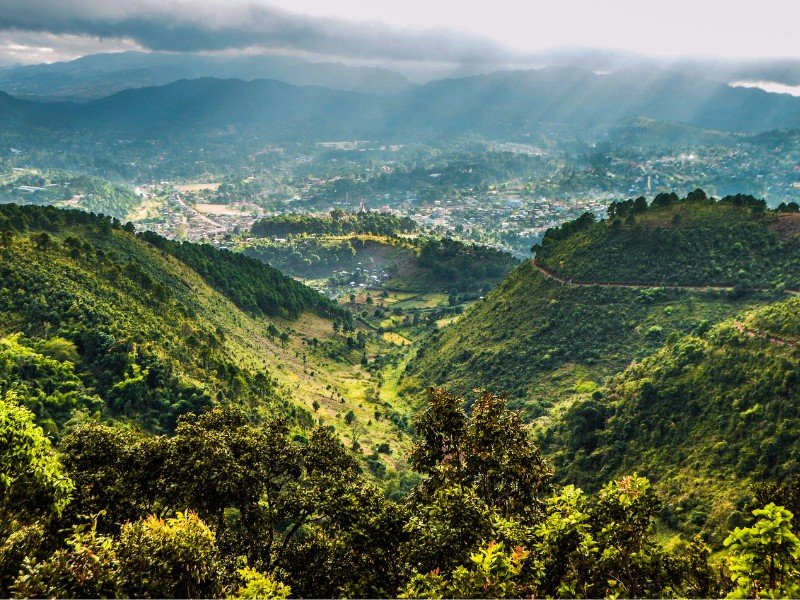
Where To Visit After Your Trip To Bagan?
Here’s a list of places to visit after Bagan, ensuring your adventure through Myanmar continues to enchant and inspire.
1. Inle Lake
Inle Lake is renowned for its floating gardens, stilted villages, and the unique leg-rowing technique of its fishermen. A boat tour of the lake reveals the traditional lifestyle of the Intha people, local crafts like silk weaving, and visits to ancient pagodas. The serene beauty of the lake at sunrise or sunset is unforgettable. Inle Lake also serves as a gateway to trekking routes in the surrounding hills.
2. Mandalay
As Myanmar’s second-largest city and the last royal capital, Mandalay is rich in history and culture. Visit Mandalay Hill for panoramic views, explore the ancient capitals of Amarapura and Sagaing nearby, and marvel at the intricate wood carvings of Shwenandaw Monastery. Mandalay is also a hub for Burmese traditional arts and crafts. The U Bein Bridge, the world’s longest teakwood bridge, offers stunning sunrise and sunset views.
3. Yangon
Yangon, the former capital, is home to the stunning Shwedagon Pagoda, which is especially breathtaking at night when it’s lit up. The city’s colonial architecture, bustling markets, and vibrant street food scene offer a lively contrast to Bagan’s ancient tranquility. Don’t miss the chance to ride the Yangon Circular Train for a glimpse into the daily life of locals. Yangon serves as a melting pot of Myanmar’s diverse cultures.
4. Hpa-An
Known for its limestone caves and karst landscapes, Hpa-An is a haven for nature lovers and adventurers. Explore the Saddan Cave, a massive cavern filled with Buddha statues and pagodas, and emerge to a hidden lake. Mount Zwegabin offers a challenging hike rewarded with sweeping views. The town’s relaxed atmosphere is perfect for unwinding after a day of exploration.
5. Ngapali Beach
For those seeking relaxation by the sea, Ngapali Beach offers pristine white sands, clear waters, and a laid-back vibe. It’s an ideal spot for swimming, snorkeling, and enjoying fresh seafood. The beach is lined with resorts catering to various budgets, ensuring a comfortable stay. Sunset views over the Bay of Bengal are not to be missed.
6. Mrauk U
Offering a less-visited but equally fascinating alternative to Bagan, Mrauk U was once the capital of a powerful Arakanese kingdom. Its temples and pagodas, set amidst rolling hills, are enveloped in an aura of mystery, especially in the morning mist. The journey to Mrauk U is an adventure in itself, involving a boat trip upriver. The Chin villages nearby, known for their tattooed-faced women, provide a unique cultural experience.
7. Kalaw
This hill station serves as a starting point for treks to Inle Lake, offering a glimpse into rural life in Myanmar. Its cool climate, colonial-era buildings, and surrounding pine forests offer a refreshing break from the heat. Trekking from Kalaw to Inle Lake reveals beautiful landscapes and traditional villages. It’s a paradise for hikers and those interested in ethnic diversity.
8. Kyaiktiyo Pagoda (Golden Rock)
One of Myanmar’s most sacred sites, the Kyaiktiyo Pagoda impressively perches on a gold-leafed boulder, seemingly defying gravity. Pilgrims and tourists alike are drawn to its spiritual significance and the stunning views it offers. The journey to the top can be made by truck and involves a short hike. Witnessing devotees apply gold leaf to the rock and meditate is a profound experience.
9. Pyin Oo Lwin
Once a colonial hill station, Pyin Oo Lwin captivates with its botanical gardens, waterfalls, and blend of colonial and traditional architecture. The cooler climate and lush scenery offer a peaceful retreat. Visit the Anisakan Falls and the National Kandawgyi Gardens for a nature escape. The town is also known for its vibrant market, specializing in locally-grown fruits and flowers.
10. Pindaya
Famous for its limestone caves filled with thousands of Buddha images, Pindaya offers a spiritual journey into the heart of Myanmar’s Buddhist traditions. The Pindaya Caves are a site of pilgrimage and wonder, showcasing statues and stupas dating back centuries. The serene Pone Taloke Lake and the traditional Shan paper umbrella workshops add to the town’s charm. Pindaya provides a quiet yet profound cultural experience.

Bagan travel questions answered: practical tips, local-style advice & temple-hopping FAQs
How many days do you really need in Bagan for a first visit?
Ideally, give Bagan three full days. With two days you can hit the headline temples, squeeze in a sunrise or sunset viewpoint, and maybe one village or river trip, but it will feel pretty packed. With three days you can slow the pace: one classic temple-hopping day, one more relaxed day for villages, markets or a museum visit, and one “wow” experience like a balloon flight or day trip to Mount Popa. If you’re a photographer or history nerd, four or five nights isn’t crazy at all – the light and mood change so much between dawn, late afternoon and hazy evenings that it’s easy to keep finding new angles.
When is the best time of year to visit Bagan, especially for hot air balloons?
It depends. Classic Bagan weather is coolest and driest roughly November to February, when daytime highs are warm, evenings can be surprisingly fresh, and skies are clearer. That’s also when sunrise hot air balloons usually operate – many companies aim for a season from around October to March, but exact start and end dates shift with weather and regulations. March–April tends to be very hot and hazy, while May–October is wetter, with afternoon downpours and muddier tracks but fewer visitors. If your absolute top priority is a balloon flight and long, blue-sky days, target mid-season (say late November to January) and keep a bit of buffer in case flights are cancelled due to wind.
Is it safe to visit Bagan and Myanmar right now?
Honestly, this is the big question. Since the 2021 military coup, Myanmar has had widespread conflict, protests, and a very unstable political and economic situation. Multiple governments and travel advisories currently classify Myanmar as “Do Not Travel” or strongly advise against non-essential travel because of armed clashes, arbitrary detentions, and limited consular support. Bagan itself has historically seen fewer incidents than some other regions, but conditions can change quickly. If you’re considering a trip, you absolutely need to: check your own government’s advisory right before booking, work with a trusted local operator who has up-to-the-minute information, have robust travel insurance that explicitly covers Myanmar, and be mentally prepared to adjust plans or cancel if the situation deteriorates. This is not a destination for carefree, last-minute travel at the moment.
Where should I base myself in Bagan: Old Bagan, New Bagan, or Nyaung U?
Old Bagan is the atmospheric choice if you want to be closest to the temples – some properties literally back onto the archaeological zone, and sunrise walks feel magical. It’s quieter at night and tends to skew a bit pricier. Nyaung U is the most “lived-in” town, with local markets, more street food, and a good spread of budget and mid-range guesthouses plus simple cafés. New Bagan sits somewhere in the middle: newer hotels, a small cluster of restaurants, and easier access by e-bike to southern temples and villages. If you’re on a tight budget and like local life, I’d lean Nyaung U; if you’re splurging and want that “sleeping among the stupas” feeling, Old Bagan is hard to beat.
How do I actually get to Bagan from Yangon, Mandalay, or Inle Lake?
The classic triangle is Yangon – Bagan – Mandalay – Inle Lake, and you can link them a few ways. In normal times, Bagan (Nyaung U) has domestic flights from major cities like Yangon and Mandalay; these are the fastest but also the most sensitive to political and airline disruptions, so you need to keep an eye on schedules. Overland, night buses and daytime coaches have long connected Bagan with Yangon, Mandalay, and the Inle Lake area; services range from basic to “VIP” with reclining seats and air-con. Boats on the Ayeyarwady River between Mandalay and Bagan are a slower, scenic option when river levels and security conditions allow. Given the current instability and occasional travel restrictions, always confirm routes with your guesthouse or a reputable local agency before locking anything in.
What’s the best way to get around the temples once I’m there?
Absolutely, e-bikes are the sweet spot for most people. They’re easy to ride, quiet, and let you cover a lot of ground without arriving drenched in sweat. Bicycles are a great low-budget, slow-travel option if you’re comfortable with heat and dust, while horse carts are more of a nostalgic, scenic splurge than a practical transport choice these days. For families, older travellers, or anyone visiting during the hottest months, hiring a car and driver for a half-day or full day is a very comfortable way to temple-hop and escape into air-con between stops. However you move around, download offline maps, carry more water than you think you’ll need, and plot one or two shady, indoor stops (like the museum or a café) into the middle of your day.
Are hot air balloon rides over Bagan still running and are they worth the money?
Usually, yes – but double-check. In “normal” years, several licensed companies run sunrise balloon flights over Bagan from around October to March, with strict weather and safety cut-offs. Since the coup and ongoing instability, operations have fluctuated; some seasons have seen reduced schedules or interruptions, and it’s essential to check directly with operators or a trusted agent for the season you’re targeting. When they’re running, it’s undeniably a once-in-a-lifetime experience: pre-dawn coffee, the roar of the burners, then drifting above a sea of stupas as the sky turns pink. It’s also one of the most expensive things you can do in Myanmar, typically costing more than several nights of mid-range accommodation. If you’re the kind of traveller who remembers “big moments” more than another nice hotel, I’d budget for it; if you’re more focused on long trips on a tight budget, you might be happier putting that money toward extra days in the country.
How many temples should I realistically try to see in one day without burning out?
Less than you think. Bagan has thousands of structures, and temple fatigue is real. On a full exploring day I like to aim for a rhythm of two or three “headline” temples (think Ananda, Dhammayangyi, Shwezigon, Sulamani), two or three smaller or quieter ones, plus one village or museum stop and one sunrise or sunset viewpoint. That’s roughly six to eight meaningful stops, not a frantic checklist of twenty. Build in proper breaks for shade, snacks and water, and don’t be afraid to repeat a favourite spot at a different time of day – the same temple at dawn and late afternoon can feel like two totally different places.
What should I wear in Bagan’s temples and what are the key etiquette rules?
Respectful but relaxed is the vibe. Shoulders and knees should be covered for all genders in religious sites, so think lightweight trousers or long skirts and breathable tops with sleeves. You’ll be taking your shoes and socks off to enter temples and some terraces, so slip-on sandals are your best friend. Inside, keep voices low, avoid flash photography on murals, and don’t touch frescoes or Buddha images – oils from skin really do damage them over time. Public displays of affection should be kept very discreet, and it’s polite to sit or kneel rather than point your feet directly at Buddha statues. If you’re not sure whether a particular staircase or area is currently open (especially after recent earthquakes and ongoing restoration work), follow the signs and the locals rather than trying to sneak up “just for one photo.”
Is Bagan suitable for kids, older travellers, or people with limited mobility?
Mostly, but with some caveats. The core temples are reachable by car, e-bike or taxi, and many have level entrances or only a few steps, which can work for older travellers and those with mild mobility issues. Where it gets tricky is steep internal staircases, uneven brick floors, and soft sand paths between sites, so you’ll want to be selective rather than attempting every viewpoint. For kids, Bagan can be surprisingly fun – climbing gentle mounds, spotting different Buddha images, trying snacks at Nyaung U Market, and taking a short boat ride all break up the “old stones” factor. For anyone with mobility challenges, I’d lean heavily on a private driver, prioritise a smaller list of easy-access temples, and confirm in advance which accommodation has lifts, ground-floor rooms, and good shade.
What kind of budget should I plan for Bagan (backpacker vs mid-range vs splurge)?
Broadly speaking, Bagan can be done on backpacker, mid-range, or “trip of a lifetime” budgets. Backpackers keeping it simple, sharing rooms, and sticking to local eateries and e-bikes can still manage on a relatively low daily spend by international standards, especially if they skip big-ticket activities. A mid-range traveller, staying in a comfortable guesthouse or small hotel with a pool, mixing local food with a few nicer dinners, and hiring a driver or guide for a day or two will need more, especially once you factor in domestic transport to and from Bagan. Splurge travellers can easily add balloon flights, river cruises, spa time, and higher-end resorts that sit right on the river or within the archaeological zone. With Myanmar’s economy and currency quite unstable, prices can shift quickly, so I’d always sanity-check recent trip reports and ask your hotel or tour operator for up-to-date ballpark costs.
Are there any common scams or annoyances in Bagan I should know about?
Nothing wildly dangerous, but a few patterns. You’ll occasionally meet over-persistent souvenir sellers, unofficial “guides” who attach themselves uninvited and then demand a fee, and kids trying to sell postcards around sunrise and sunset spots. Politely but firmly saying no and walking away works in most cases; if someone genuinely helps you with directions or information and then suggests a small tip, that’s up to you. At markets, prices aimed at foreign visitors can start high; bargaining with a smile is expected, but keep it lighthearted rather than combative. Finally, in any destination going through economic and political turmoil, be extra cautious about money changers, unofficial ticket sellers, and anyone promising to “fast-track” permits or transport – use official counters and recommendations from your accommodation wherever possible.
What should I pack specifically for Bagan’s weather and conditions?
Hot, dusty, and barefoot is the basic formula, so pack accordingly. Light, breathable clothing that still covers shoulders and knees will keep you both comfortable and temple-appropriate. A wide-brimmed hat, decent sunglasses, reef-safe sunscreen, and a refillable water bottle are non-negotiable. Because you’ll be taking your shoes off constantly, I always pack a small cloth or wet wipes to clean my feet before slipping sandals back on. A lightweight scarf or shawl is handy for extra coverage or dust, and a small headlamp or phone torch is useful for darker temple interiors and pre-dawn starts. If you’re visiting in the cooler months, don’t be fooled – early mornings on an e-bike can actually feel chilly, so a thin fleece or windbreaker can make sunrise rides much more pleasant.
How did the recent earthquakes and UNESCO status affect visiting Bagan?
Good question. Bagan has long been earthquake-prone, and a major quake in 2016 damaged hundreds of temples. That was one of the catalysts for a big conservation push, which eventually led to Bagan being inscribed as a UNESCO World Heritage Site in 2019. In March 2025, another strong earthquake struck Myanmar, but initial assessments reported that major stupas in Bagan, including Htilominlo and Shwezigon, did not suffer serious structural damage. The practical impact for travellers is that some structures are still undergoing long-term restoration, certain staircases or upper terraces remain closed for safety, and you’re now more likely to be directed to designated viewpoints or mounds rather than clambering up any old pagoda. In the long run that’s a good thing for preservation, even if it changes how we chase those famous views.
Can I use Bagan as a base for a longer Myanmar trip, and where should I go next?
Definitely, Bagan is both a highlight and a natural hub. A classic loop would pair it with Mandalay and its nearby ancient capitals, the stilt villages and floating gardens of Inle Lake, and either Yangon for big-city energy or Ngapali Beach for downtime on the sand. More adventurous travellers might add hill-country trekking around Kalaw, caves and karst formations near Hpa-An, or more remote temple landscapes like Mrauk U. The catch is that in the current political and security climate, some of these routes are less straightforward than they used to be, and certain regions may be off-limits or risky at any given time. Treat your Bagan plans as one piece of a bigger puzzle, keep your route flexible, and lean on local operators who are genuinely honest about what is and isn’t advisable right now.
Bagan Travel Guide: Final Thoughts
Bagan is a truly magical destination that is steeped in history and tradition, offering visitors an unparalleled glimpse into the rich cultural heritage of Myanmar. This ancient city is a living testament to the achievements of the mighty Burmese kingdoms that once ruled over this land, and its magnificent temples and pagodas stand as a testament to the greatness of their civilization.
The temples of Bagan are truly a sight to behold, and the experience of exploring them is one that will stay with you for a lifetime. Whether you choose to wander the temples on foot, take an exhilarating ride on an e-bike, or soar above them in a hot air balloon, you’ll be entranced by their beauty, complexity, and sheer scale.
But Bagan is more than just its temples. The surrounding landscape is breathtakingly beautiful, with rolling hills, verdant forests, and tranquil rivers creating a peaceful and serene environment. And the local culture is vibrant and engaging, with warm and friendly locals eager to share their traditions, cuisine, and way of life with visitors.
As you plan your trip to Bagan, be sure to take the time to explore all that this incredible city has to offer. Consider your options for transportation, accommodations, and tours carefully, and don’t be afraid to seek out local advice to help you make the most of your time here. And above all, be sure to savor every moment of your time in this enchanting destination, and allow yourself to be transported back in time to a world of ancient kings, noble warriors, and timeless beauty.
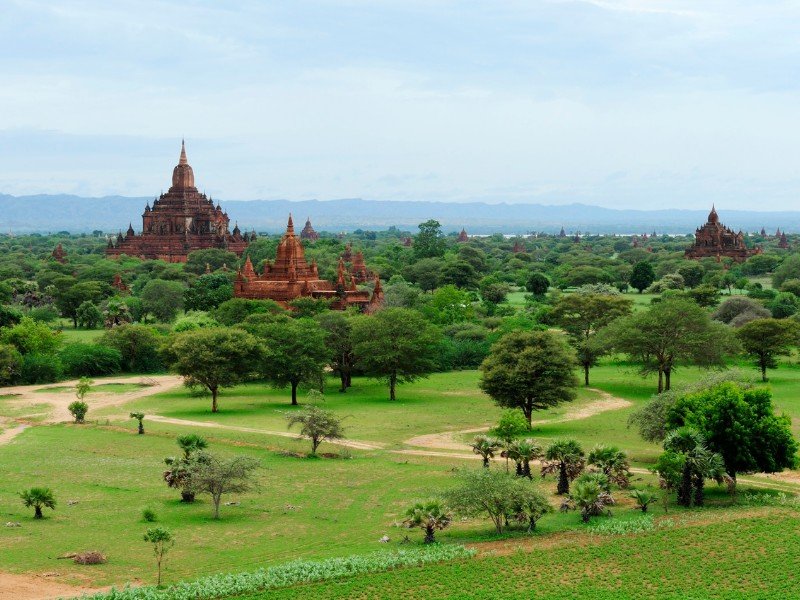
Ode To Bagan
Amidst the rolling hills and tranquil streams, A land of beauty, ancient and serene, Bagan, a city of temples and dreams, A place where history and tradition convene.
The temples stand tall, proud and grand, Whispers of a mighty empire, a noble land, A legacy etched in every brick and stone, A story waiting to be told, a mystery to be known.
The sun rises above the misty plain, A thousand temples bathed in golden light, A sight to behold, a moment to remain, A wonder that fills the heart with delight.
The gentle breeze carries the scent of the land, The rustling leaves, a symphony so grand, The locals smile, welcoming and kind, Their traditions and culture, treasures to find.
In Bagan, time stands still, A world where the past and present thrill, A journey that leaves an indelible mark, A memory that will forever spark.
So come and explore this ancient city, Let its wonders fill your heart with glee, A land of temples, beauty and grace, A journey of a lifetime, a magical place.
